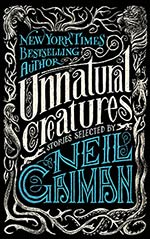
![]() Rhondak101
Rhondak101
6/8/2014
![]()
Unnatural Creatures (2013) is an anthology of stories selected by Neil Gaiman. Maria Dahvana Headley co-edited this volume with him. Its proceeds go to the literacy nonprofit 826DC.
I have adjusted to reading on digital devices much more quickly than I ever thought that I would. Between one-third and one-fourth of the books I read, I now read on my iPad or Kindle. Yet, when a book like Unnatural Creatures comes along, it reminds me of the pleasure of reading a physical book. There are many things that make this book special in its bookishness. I want to discuss them before I actually talk about the stories themselves. I read the paperback copy from my school's library. It is surprising how "right" this book felt in my hand as I read. It is a unique size, somewhere in between a B-format paperback and a trade paperback. It is squarer than most books.
I can't say that I would have been so impressed with something as easy to disregard as a book's size if the rest of the book were not so carefully appointed. It contains many artistic flourishes. Briony Morrow-Cribbs has provided an illustration for the title page of each story. Gaimain's short introduction to each story is similarly decorative. Even the page numbers have flourishes. The text is generously spaced in all directions, between the words, between the lines and with a generous margin. Surprisingly, the name of the font is not given anywhere that I can find, but it is clear and easy to read. Many of the stories contain special typography, handwriting, letters, signs, newspaper clippings, etc. The way this typography is treated enhances the visual impact of the stories. (I wonder if these touches were in the original stories or a part of the editing process). I've looked at the Kindle sample and some of these features are carried over to the electronic copy, but they seem to lack the impact that their combination provides in the physical form. Buy a physical copy of this book. You will not regret it.
Gaiman's selections contain a mix of older and contemporary works. Some of the contemporary authors are Gaiman, E. Lily Yu, Nnedi Okorafor, and Nalo Hopkinson. Some of the older authors are Anthony Boucher, E. Nesbit, Larry Niven, and Samuel R. Delany. My favorite stories in this anthology some of the older ones: Niven's "The Flight of the Horse," a time travel tale; Frank R. Stockton's "The Griffin and the Minor Canon," a clever fantasy; Diana Wynne Jones' "The Sage of Theare," a interesting take on trying to escape fate; and Boucher's "The Compleat Werewolf," a fun WWII take on spies and werewolves. It is easy to describe each of these stories as "clever"; each has an unexpected twist or a unique perspective. If you like Gaiman's work, you will like the stories he selects. This book is a bibliophile's book and much more than the sum of its parts.